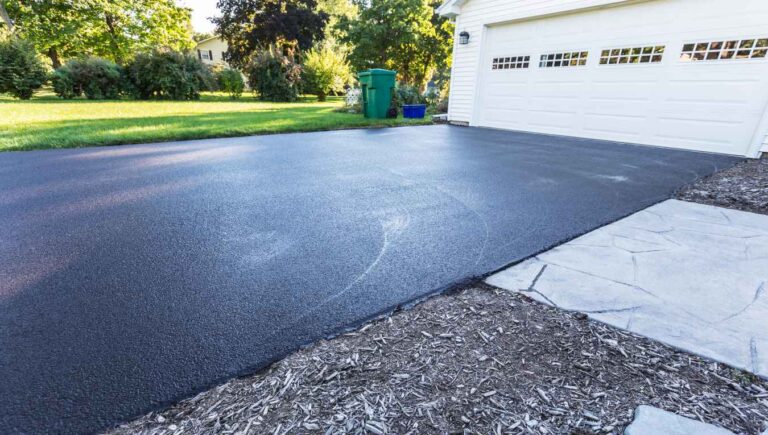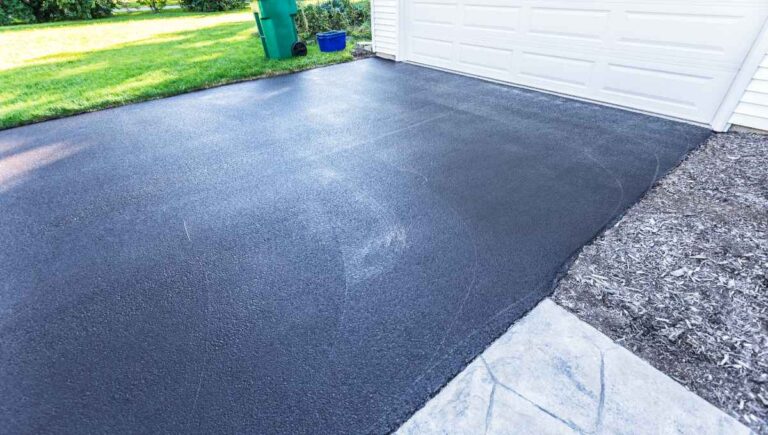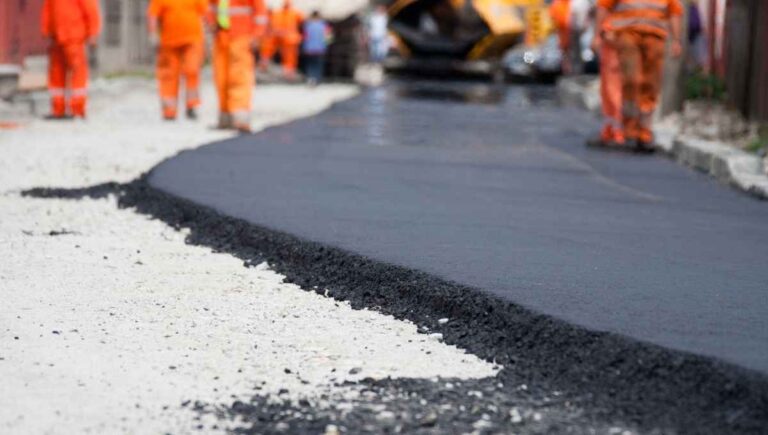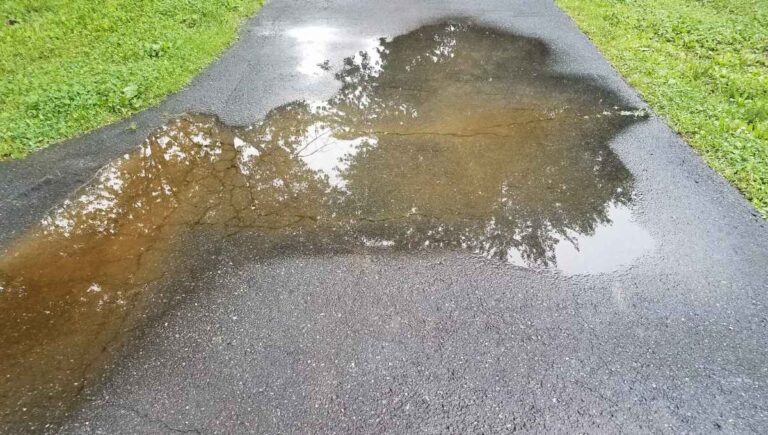Can You Walk on a New Driveway? (How Soon Is Too Soon?)
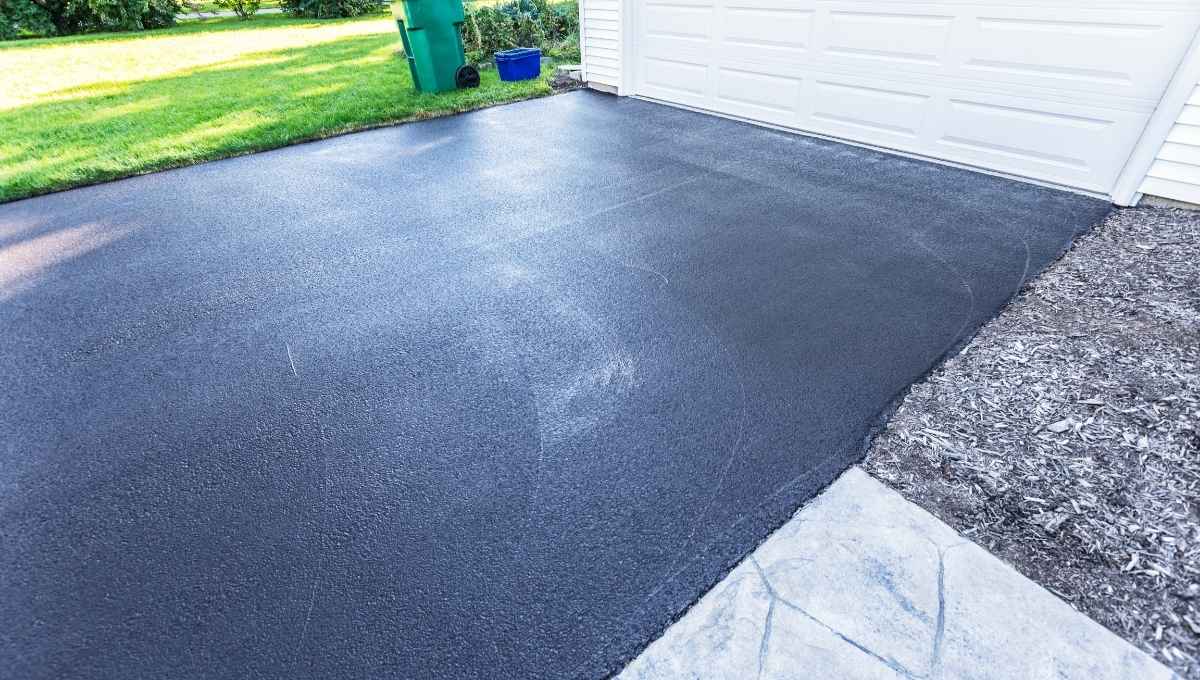
Wanting to walk on a new driveway is tempting and sometimes even necessary. But how soon is too soon to walk on your driveway? You certainly don’t want to ruin any improvements you just made. So when can you walk on a new driveway?
You can walk on your new driveway in as little as 24 hours or as much as 72 hours. This is the time period it takes to set. The rule of thumb is that the longer you wait, the better because you ensure the safety of your newly paved driveway by preventing cracks or potholes from forming on it.
To walk, or not to walk; to drive or not to drive? These questions can be unsettling, especially if you don’t know much about paving a driveway.
So, in this article, we’ll discuss how long you should wait before using your driveway and what things you need to know to understand how paving works.
This post contains affiliate links from Amazon and other stores. This means Yard Blogger may earn a commission if you make a purchase using any of our links. Please refer to our full affiliate disclosure policy for full details.
Here’s a Quick Pro Tip!
You can walk on your new driveway after 24 hours, although waiting for three days is better. If you walk on your driveway too soon, you may risk damaging it.
The only way to fix these damages is by either redoing the asphalt or filling it with cold mix.
Here are essential tools you’ll need to fulfill your paving project:
1. Non-contact Infrared Thermometer – You can use this type of thermometer to measure the heat or cold of your asphalt. This will help you monitor drastic temperature changes to maintain your asphalt smoothly.
2. Cold-Mix Asphalt Patch – Ideal for repairing cracks and potholes on your asphalt driveway.
3. NO PARKING Caution Tape – Protect your new pavement from delivery vehicles and other visits. This will warn them, and they will keep off your new asphalt so it doesn’t suffer damage.
Walking on a New Drive
Having a new driveway is exciting, but knowing the recommendations of most paving experts is necessary to ensure that you don’t damage it by accident.
So, let’s discuss how long you should wait before walking on your new driveway.
How Long Do You Stay off a New Driveway?
You should wait around three to five days before using your new driveway, although waiting for an entire week is recommended. Furthermore, you shouldn’t park your car in your new driveway until after 14 days have passed.
If you don’t wait enough time before the asphalt is settled, you risk damaging the driveway because of the car’s weight.
Therefore, you should be extra careful with these instructions and follow them as best as possible.
How Long Until You Walk on a New Driveway?
It’s recommended that you wait three days to walk on a new driveway because you can avoid damaging it. However, if you believe that you need to walk on it sooner, you should wait for a minimum of 24 hours to ensure that you don’t damage the asphalt.
Additionally, you should wear flat shoes to walk on your driveway. You should not wear shoes that are too heavy or have pointy soles (or heels).
Walking with these types of shoes on the asphalt will cause inevitable damage.
When Can I Start Walking On My New Driveway?
When asphalt is newly added to your driveway, you must wait a minimum of 24 hours before starting to walk on it. If you proceed to walk on it sooner than that, you risk damaging your asphalt’s structure.
However, if you have ways to avoid it, you should wait for at least 72 hours before walking on your new driveway. This will prevent damage from happening and will allow it to set smoothly.
Once it hardens, you have to wait around 14 days before parking your car on it. You may also wish to check the temperatures around your city.
If it is too hot, you may want to use a garden hose to help it cool down. It will help it cure faster too.
How Long Should You Stay off a Paved Driveway?
For concrete paved driveways, you should stay off for a maximum of seven days, and for asphalt, you should stay 14 days without using it. Although asphalt sets quicker than concrete, you should treat it carefully to avoid harming the new driveway.
If you drive or walk on a new concrete driveway ahead of time, you risk making strange marks on the pavement.
The same thing might happen if you use your asphalt driveway, so you should stay off it until it’s completely set.
You might also enjoy our post on How Much Weight a Driveway Can Hold
How Long After a Concrete Driveway Is Poured Do I Have to Wait to Walk On It?
You should wait for a minimum of 24 hours before walking on newly poured concrete to avoid damaging the integrity of the concrete. Not following the waiting period could damage the ending result and structure, which is unfortunate.
Therefore, you may want to protect your concrete driveway from external elements.
You can put caution tape from one side of the pavement to the other to let other vehicle owners know they should not be near the concrete.
Driveway Curing Times
Asphalt can take its sweet time to cure fully, but it can be ready to use after 48 hours. However, curing is not the same thing as drying. While one fully sets the asphalt, the other lets you use it.
Let’s discuss the best way to let asphalt cure below.
How to Cure Asphalt Faster?
You can cure asphalt faster by using your garden hose to spray water on top of the newly added driveway during hot days. Shift the garden hose side to side when showering the asphalt to avoid creating puddles on the ground.
You have to do this once in the morning and once at night. Additionally, you want to avoid focusing on one spot when showering in the driveway. Also, it’s not recommended that you soak it completely. Mildly spraying the asphalt with water is enough.
Additionally, make sure to keep yourself updated regarding your weather conditions. Having a thermometer outside your house is good for knowing how hot it is outside.
That way, you can watch the stability of the asphalt.
How to Make Concrete Cure Faster?
You need to add calcium chloride into the concrete mix before pouring it so that it can cure faster. It also helps to mix the cement with warm water instead of cold water. Moreover, you should pour concrete in optimal environmental conditions.
Calcium chloride helps the cement accelerate its hydration process, in essence, helping to cure it faster.
Therefore, it is highly recommended to use it when creating new structures that require concrete, including your new driveway.
However, other factors must be considered to help cement cure faster. For example, optimal weather conditions are very important.
The preferred temperature at which you pour concrete should be around 90 degrees Fahrenheit, equivalent to 32 degrees Celsius.
High heat and humidity levels allow the water to evaporate from the concrete mix, which is a key step for better cement curation. On a side note, cold temperatures will make the concrete cure slower.
Thus, it’s important to consider these factors when using concrete.
What Is the Fastest Way to Cure Asphalt?
The fastest way to cure asphalt is by showering the pavement with a garden hose on days when hot temperature levels are high. This will ensure that the temperature that asphalt needs to cure is balanced. Hence it will aid in faster curation.
Asphalt needs to have a balanced temperature to cure faster and smoother. Therefore, showering it with a garden hose is crucial, especially during extremely hot weather, usually above 100 degrees Fahrenheit.
How Can I Tell if Asphalt Is Cured?
You can tell when the asphalt is cured after a full year has passed, and its color turns from a dark, black color to a charcoal, grayish color. This change of color means that the asphalt is hardened, which also implies that asphalt has lost oils.
Oxidation is the process that asphalt needs to undergo to avoid damage from driving and is characterized by oil loss.
After this occurs, it’s recommended that homeowners seal the asphalt before it ends up suffering damage from this.
Further, you should understand the difference between curing and drying. Curing requires oils to evaporate from the asphalt, while drying involves hardening the pavement enough to be used.
This happens after 48 or 72 hours, two to three days.
Does Asphalt Cure Faster in Cold Weather?
Asphalt will dry quicker in cold weather, but it won’t cure faster because it also needs some level of heat to allow the oil from the asphalt to oxidize to a certain extent. So it won’t cure properly and will take more time if exposed to harsh cold weather.
The balance between cold and heat is necessary for asphalt applications. If you don’t ensure enough heat to let the oils from the asphalt oxidize for it to harden, you’ll likely get prematurely damaged asphalt.
On a side note, extremely cold temperatures are also unfavorable for asphalt. It could freeze in these conditions and not cure properly, which can also cause irreparable damage.
You might also enjoy our post on If You Can Park a Boat on Your Driveway
Does Rain Help Asphalt Cure?
Rain makes asphalt harden quicker than it should before it cures correctly, so it does not aid in the process of asphalt curation. Many paving experts recommend avoiding asphalt projects on rainy days for this same reason.
The key to correct asphalt curation lies in the balance of temperature and humidity. So, excessive temperature changes can damage the asphalt, which you can only fix by starting the project again.
However, for a quick repair, you can use a pothole and crack filler. It won’t be as durable as re-starting the project, but at least it can help you resolve the problem until you have a good budget to do it again.
Paving Problems
Some things can intervene with the proper setting time for asphalt and affect it when it is newly paved.
So, let’s talk about the common consequences of walking too soon on your new pavement and what to do to prevent damage.
What Happens if I Walk On My New Driveway Too Soon?
If you walk on your new driveway too soon, you may risk damaging the new asphalt or concrete pavement with cracks, footprints, or tire prints. The substance from either pavement method could also ruin your footwear or yourself.
You may require to start the pavement all over again to fix it. Of course, this process will make the project more expensive than originally estimated. This is why it’s important to follow the recommendations necessary to let your pavement set properly.
Should New Asphalt Be Watered?
New asphalt should be watered only on days when the temperature is excessively hot, and you should not do it in a way that it soaks up the whole pavement. Instead, shower it enough so it cools down at such temperatures, but don’t overdo it.
You shouldn’t create puddles of water in new asphalt because it can cause new damage to it. Puddles are why new holes or cracks develop on parking lots or streets.
These issues are often fixed with cold-mix asphalt or redoing the work. One is more expensive than the other, but it is still necessary to avoid accidents.
How Long Does Asphalt Need to Dry Before the Rain?
Asphalt needs a minimum of two days to dry properly before being soaked by rain. Otherwise, it might affect its process of curation. Furthermore, if rain falls on newly poured asphalt, it might cause damage, which can only be fixed by pouring new asphalt.
Rain can affect the finishing result of newly poured asphalt, leading to lower quality. This is why waiting for good, sunny, and breezy days is recommended for pouring asphalt on your driveway.
What Is the Best Time of Year to Lay Asphalt?
The best time of the year to lay asphalt on a new driveway is around spring and summer due to the comfortable temperatures during these months. Asphalt should be poured under 70 to 90 degrees Fahrenheit to guarantee good results.
The results won’t be as satisfying if asphalt is laid on temperatures below 50 degrees Fahrenheit.
In fact, it won’t be able to set properly, and it can suffer premature damage due to a lack of proper installation.
Will Hot Asphalt Hurt Me if I Walk On It With Shoes On?
Hot asphalt won’t harm you if you walk on it with shoes on, but walking shoeless on asphalt or other public areas can harm you. If your feet come in contact with hot surfaces, they can burn or blister, which will be hurtful.
Your feet could get severely burned if you expose them to extremely hot surfaces, which is why you shouldn’t go outside without shoes on.
This is especially true if the current temperatures around your neighborhood exceed 95 degrees Fahrenheit.
Waiting Games
The waiting timeframe for walking on concrete and driving on a newly paved driveway is not the same.
While you can walk on concrete two days after it dries enough to tolerate human pressure, it’s simply different with cars. So let’s talk about how long you must wait below.
Can I Walk On My New Concrete Driveway After Three Days?
It’s safe for you to walk on your new concrete driveway after three days because it would be hardened enough to hold your weight. However, you don’t need to wait that long, as concrete is safe to walk on after 24 to 48 hours.
After waiting 24 hours, you can walk on your concrete driveway without risking harming it. However, if you feel more comfortable waiting longer, you can wait up to three days to ensure that it has hardened enough.
How Long Before You Can Walk on a New Asphalt Driveway?
Before you can walk on a new asphalt driveway, it’s recommended to wait 24 to 48 hours so the asphalt can dry properly. You risk damaging your new driveway if you walk on new asphalt ahead of this estimated waiting time frame.
You could create unwanted figures on your asphalt if you walk on it ahead of time. For example, you risk leaving hard-to-fix footprints on the driveway, making you need to start the driveway all over again.
The bright side is that you choose to fix it with an asphalt filler or cold-mix asphalt if you believe you need more time to redo the project.
However, walking on fresh asphalt is still not recommended if you want it to set properly.
Can You Walk On Fresh Asphalt?
You can damage newly added asphalt if you walk on it without letting it set properly, so walking on fresh asphalt is not recommended. You should wait at least 24 hours before walking on your new driveway, lest you leave footprints on it.
However, even after 24 hours have passed, you should be careful. You cannot wear heavy shoes, make weird movements with your feet, or let your pet walk around the new asphalt.
You risk ruining the new driveway if you do this.
How Long Until I Can Walk On My Newly Paved Driveway?
You should wait at least 24 hours before walking on your new paved driveway, although you should wait three full days. The latter is more appropriate because you ensure that the asphalt or concrete is hardened enough to hold your weight.
However, you may want to avoid other things when pouring new asphalt or concrete.
For example, you should wait a full week if you want to park your car in the new concrete driveway or 14 days if it is made of blacktop. That way, you won’t harm the asphalt and keep it smooth.
Related Questions
Why Do They Put Sand on New Asphalt?
The reason why sand is poured on new asphalt is that it is used as a form of sealant that allows it to last longer and be protected from outside elements that can cause damage to it. It also improves the look of the asphalt, which is convenient for most people.
Sand will help the asphalt maintain its look and also aid in its lifespan. In addition, it will help avoid the asphalt from being slippery, which can be hazardous to you.
It will also appear cleaner, so it’s good to consider if you plan to seal your asphalt driveway.
Why Is My New Asphalt Driveway Not Smooth?
A non-smooth asphalt driveway implies that the installation process was not done correctly or that the mix of the asphalt solution wasn’t done properly. Therefore, it is not smooth, and it is prone to issues.
If your new asphalt driveway isn’t smooth, it will likely break off sooner than expected. In addition, non-smooth asphalt is prone to water damage from future hard weather and so on.
This is especially true if we consider the winter season and how it affects you.
For example, if rain falls on the asphalt, the water will sweep to the possible cracks or openings in the asphalt. During winter, the water would freeze.
It will put heavy pressure on the asphalt, which won’t be very good.
How Long Until I Can Drive on a Fresh Asphalt Driveway?
It’s recommended that you wait for at least 24 hours before driving on a fresh asphalt driveway, but it’s better if you wait longer if you choose to pave your driveway on hot weather days. That way, you will prevent damaging the asphalt.
However, you may be able to drive on it but not park your car. The reason for this is that you want to avoid damaging the asphalt with the weight of your car.
In this case, it is advised to wait around 14 days before parking your car on your new driveway.
Final Thoughts
You can walk on a new driveway after 24 hours have passed, although it’s recommended to wait for three full days to make sure that nothing happens to your new driveway.
Moreover, understanding the aspects of how asphalt works and its setting process can help you understand why it is important to maintain it constantly.
For example, it is important to seal the asphalt at least six months after its pavement to ensure that heat does not harm it.
Additionally, your contractor can give you more details about what to do the weeks after your pavement is done.
You’ll get a better idea of what to do if you gather more information on the subject.

